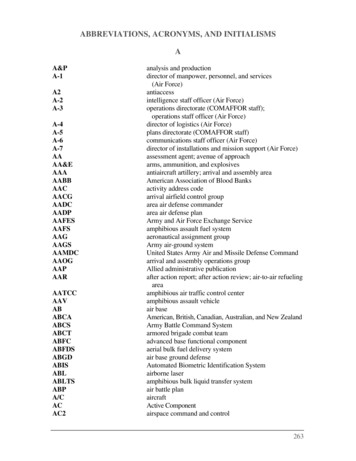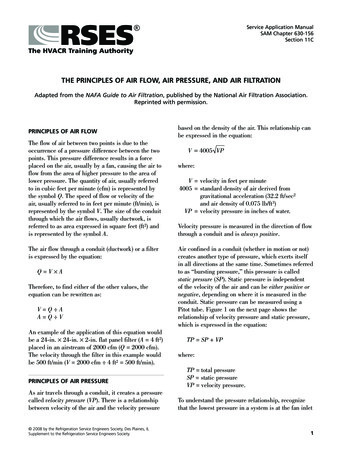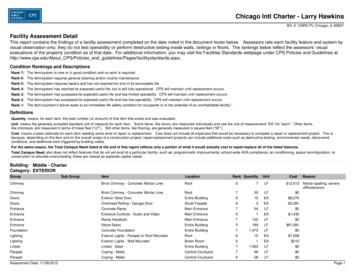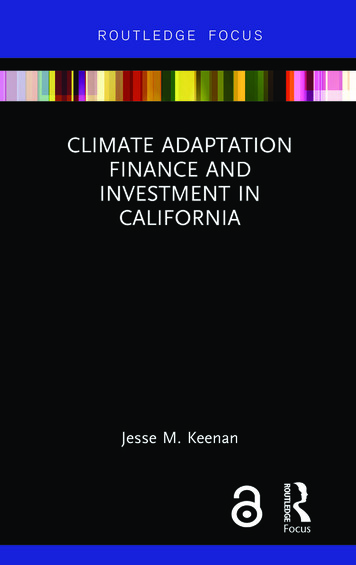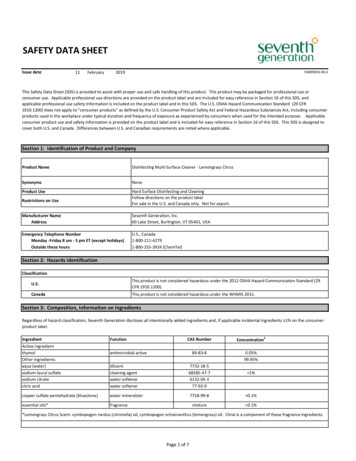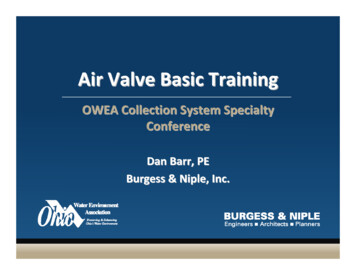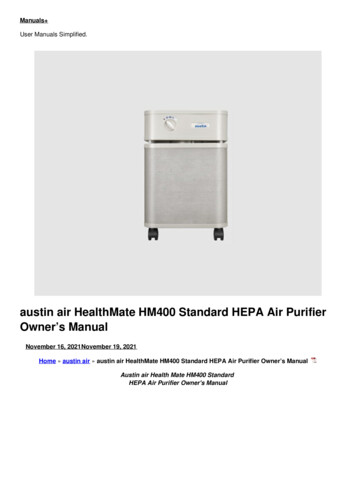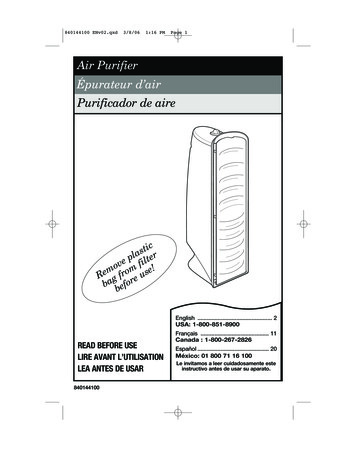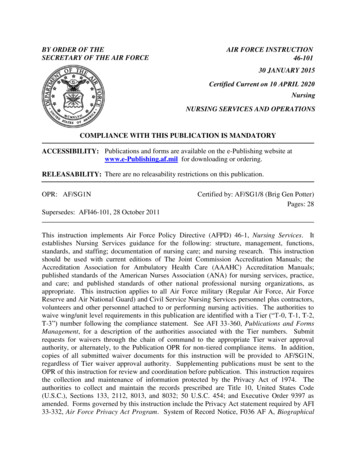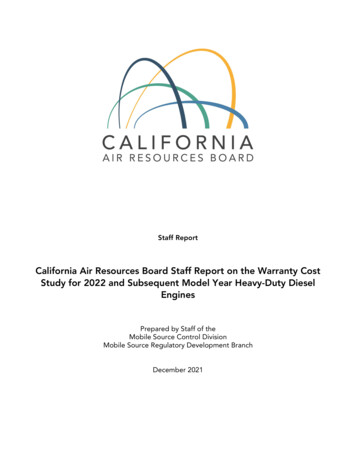
Transcription
Staff ReportCalifornia Air Resources Board Staff Report on the Warranty CostStudy for 2022 and Subsequent Model Year Heavy-Duty DieselEnginesPrepared by Staff of theMobile Source Control DivisionMobile Source Regulatory Development BranchDecember 2021
Heavy-Duty Warranty Cost Study ReportDecember 2021State of CaliforniaCalifornia Air Resources BoardThis report has been prepared by the staff of the California Air Resources Board.Publication does not signify that the contents reflect the views and policies of theCalifornia Air Resources Board, nor does mention of trade names or commercialproducts constitute endorsement or recommendation for use.This report represents CARB staff’s findings related to each goal of the study. Althoughmembers of the work group reviewed and commented on the contents of this report,ultimately this report represents CARB staff’s findings, and not necessarily a groupconsensus.ii
Heavy-Duty Warranty Cost Study ReportDecember 2021Executive Summary . ES-1I.Overview . 1II.Background . 15III. Study Participants and Goals . 17IV. Goal #1: Work collaboratively to better understand all the assumptions made and all of thedifferences in the various warranty cost analysis methods. 17A.CARB’s method . 18B.NREL’s method . 35C.ACT Research’s method . 38D. EMA’s analysis . 40E.CARB’s analysis of the difference between CARB and NREL/ACT Research/EMA’sestimates . 43F.Conclusion of Goal #1: “Work collaboratively to better understand all of theassumptions made and all of the differences in the various warranty cost analysismethods” . 49Goal #2: Gather available data for heavy-duty vehicles to quantify the residual warranty valueto the second and subsequent owners. . 52V.A.Methods . 52B.Survey Results . 52C.Conclusion of Goal #2 . 59VI. Goal #3: Gather available data on usage patterns and duty cycles from the second andsubsequent owners of vehicles used in a variety of applications to assess wear characteristics. 60VII. Goal #4: Make a plan for gathering and sharing data between OEMs and suppliers as newtechnologies to meet MY 2024 and MY 2027 standards are rolled out. . 61VIII. Goal #5: Facilitate discussions between OEMs and emission control component suppliersbeyond the current 100,000-mile warranty period. . 61IX. Goal #6: Review the results and the suggested next steps from the study. . 64X.References. 67XI. Appendix . 68iii
Heavy-Duty Warranty Cost Study ReportDecember 2021A.Excerpt of the August 27, 2020 board hearing transcript regarding the warranty coststudy . 68B.Excerpt of the email from EMA regarding the warranty cost data from OEMs for Step1 warranty . 70C.Warranty values estimated by J.D. Power Valuation Services . 71D. Residual warranty survey questions . 73E.Cummins’ testimony from the August 27, 2020 board hearing . 80F.ATA’s comment on the draft report . 81G. EMA’s comment on the draft report . 83H. CARB staff’s response to stakeholder comments on the draft report . 90I.CARB staff’s analysis of warranty costs for new technologies . 101J.EMA’s additional analysis “Projecting Extended Regulated ERC Warranty from ActualExtended Warranty Experience” . 105iv
Heavy-Duty Warranty Cost Study ReportDecember 2021List of Acronyms and AbbreviationsAcronym/AbbreviationACT ResearchATACARB or ERCsERGEWIRFETFIRFTPg/bhp-hrg/hrGVWRHD I/MHD OBDHDOHHDDHHDVhrISORISRlbs.DefinitionAmericas Commercial Transportation Research Co., LLCAmerican Trucking AssociationsCalifornia Air Resources BoardConfidential Business InformationCylinder DeactivationThe Bourns College of Engineering, Center forEnvironmental Research & TechnologyConfidence IntervalsCalifornia State University, SacramentoDiesel Exhaust FluidDiesel Oxidation CatalystDiesel Particulate FilterEngine Control ModuleEngine Control UnitExhaust Gas RecirculationTruck and Engine Manufacturers AssociationCARB's EMission FACtor modelEmission-Related ComponentsEastern Research Group, IncEmissions Warranty Information and ReportingFederal Excise TaxField Information ReportFederal Test ProcedureGrams per Brake Horsepower-HourGrams per HourGross Vehicle Weight RatingHeavy-Duty Vehicle Inspection and MaintenanceHeavy-Duty On-Board DiagnosticsHeavy-Duty Otto-CycleHeavy Heavy-Duty Diesel Engines 33,000 lbs. GVWRHeavy Heavy-Duty Vehicles 33,000 lbs. GVWRHoursInitial Statement of ReasonsSacramento Institute for Social ResearchPoundsv
Heavy-Duty Warranty Cost Study ReportDecember MILMYNOxNRELOBDOEMPMR&DRMCSCRSwRITRUCRSU.S. EPAUS10 ERCsULyrDefinitionLiterLight Heavy Duty DieselLow load cycleManufacturers of Emission Controls AssociationMotor & Equipment Manufacturers AssociationMedium Heavy Duty DieselMobile Source Control DivisionMilesMalfunction Indicator LightModel YearOxides of NitrogenNational Renewable Energy LaboratoryOn-Board DiagnosticsOriginal Equipment ManufacturerPartuculate MatterResearch and DevelopmentRamped Modal CycleSelective Catalytic ReductionSouthwest Research InsituteCARB's Truck and Bus Regulation ReportingUnited States Environmental Protection AgencyERCs meeting the current federal requirementsUseful LifeYearsvi
Heavy-Duty Warranty Cost Study ReportDecember 2021Executive SummaryThe Heavy-Duty Engine and Vehicle Omnibus Regulation and Associated Amendments(Omnibus Regulation), approved for adoption by the California Air Resources Board (CARBor the Board) on August 27, 2020, will dramatically reduce oxides of nitrogen (NOx)emissions by comprehensively overhauling exhaust emission standards, test procedures andother emissions-related requirements for 2024 and subsequent model year (MY) Californiacertified heavy-duty engines. The Omnibus Regulation includes updates to the warrantyrequirements because the current emission warranty periods are too short compared to thelong life a typical heavy-duty vehicle is driven. For example, the largest heavy-duty trucks,heavy heavy-duty vehicles (HHDV), often stay on the road for nearly 1 million miles but arecurrently required to be covered under warranty for only 100,000 miles/5 years/3,000 hours,and 350,000 miles/5 years starting with MY 2022.The new Omnibus warranty requirements, for example 600,000 miles/10 years/30,000 hoursfor HHDV starting with MY 2031, are critical because heavy-duty vehicles are enormouscontributors to mobile source air pollution. They are likely to expose communities that arenear roadways, close to ports, or adjacent to warehouse distribution centers to excessivepollution if they are not emission compliant and not durable for the actual useful lives.Information from the original equipment manufacturers (OEMs) and a survey contracted byCARB and conducted by California State University, Sacramento, confirmed that most ownerspurchase extended warranties already, and the warranty costs will now be shifted fairly to theOEMs. Warranty is intended to help ensure defects in materials and workmanship get fixedbut is not meant to protect OEMs from having to design durable components.During the Omnibus Regulation rulemaking process, industry stakeholders raised concernsregarding the potential cost impact of warranty requirements. In response, the Boarddirected CARB staff to engage with affected stakeholders to conduct a warranty cost study.The Board’s purpose for conducting this study was to better understand the differencesbetween CARB staff’s estimates of warranty costs and those estimates provided by industrystakeholders. The key findings of this study are summarized below:·CARB’s method for determining the effect of the rulemaking on all owners isappropriate for considering the statewide impact. Although the warranty costestimates for MY 2022 made by CARB and those presented by the Truck and EngineManufacturers Association (EMA) differ by a factor of nine, the warranty costs “permiles covered” reasonably agree. The average incremental miles covered underwarranty in CARB’s estimate is small because CARB’s method accounts for the factthat most vehicle owners already purchase extended warranties voluntarily. Theywould not be affected by the rulemaking as much as those who have minimumregulatory warranties only. On the other hand, manufacturers’ estimates only considerindividual customers who do not already have extended warranty.ES-1
Heavy-Duty Warranty Cost Study ReportDecember 2021·CARB staff believes it is simply part of the fundamental engineering cost to designdurable components and does not believe that this cost should be attributed towarranty. The warranty is intended to cover defects in materials and workmanshipwhich cause the failure of a warranted part to be identical in all material respects tothat part as described in the vehicle or engine manufacturer's application forcertification. Therefore, warranty is not intended to cover failure of parts that are notdesigned properly. When the lower NOx standards take effect and longer useful lifeand warranty requirements are phased-in for MY 2027 and 2031, EMA’s warranty costmethodology projects additional repair costs due to the lower NOx standards, higherunit prices for parts due to longer useful life, and the introduction of premature newtechnologies with elevated failure rates. CARB staff objected to these assumptions.Although there will be some new technologies introduced to meet MY 2027/2031requirements, such as cylinder deactivation or light-off selective catalytic reduction,nearly all emission-related components expected for meeting the Omnibus standardswill be the same as the technologies used today.·CARB staff concluded that even if the higher warranty costs for new technologieswere included, it would not have changed the staff proposal. CARB staff’sadditional sensitivity analysis suggested that if the warranty costs for new technologywere included, it would increase the estimate of Omnibus Regulation costs by about11 percent. The hypothetical increase was well within the bounds of the previousCARB Staff Report sensitivity analysis. This additional sensitivity analysis wasconducted in response to EMA’s comments during the working group, and evaluatedthe potential impact of new technologies on the warranty cost.·Results from CARB staff’s fleet owner operator survey suggest that higher initialvehicle purchase prices are likely to be passed on to the subsequent vehicleowners, which potentially reduces the cost impact that the Omnibus Regulationwarranty amendments may have on first owners. A survey of fleet owner operatorsand dealers was conducted to better understand the value of remaining warranties tothe purchasers of used vehicles. The survey results indicate that the remaining residualwarranties do in fact add value to vehicles sold in the secondary market, averagingapproximately 2,000 for a 2 years/200,000 miles period of residual warranties, and 4,000 for a 4 years/400,000 miles residual period.1In conclusion, the Omnibus Regulation requirements continue to be cost-effective withbenefits estimated to outweigh its costs by a factor of 10 (i.e., monetized benefits of 23.4 billion vs. costs of 2.39 billion). Although CARB staff does not concur with EMA’s1The values of individual residual warranties should not be confused with the average incremental cost of theregulation. For example, even if the required warranty period is increased by 200,000 miles, the averageincremental cost can be much less than 2,000 since many owners already buy extended warranties voluntarily.ES-2
Heavy-Duty Warranty Cost Study ReportDecember 2021analysis methods, CARB staff agrees that the different viewpoints led to different baselineassumptions that ultimately affected the respective warranty costing methodologies. CARB’smethod included in the baseline optional longer warranties purchased in order to assess theimpact of the rulemaking on the entire vehicle population. However, it is understandable thatindividual manufacturers would consider the first point they encounter their customers, ratherthan the average vehicle population. Since warranty is intended to cover defects, notinadequate design, CARB’s estimate did not assume higher warranty costs (per milescovered) for MY 2027/2031 and instead accounted for the engineering cost as part of newstandards, certification, and new technology. The work group members agreed that futurewarranty cost estimates should clearly list and clarify key assumptions on the definition ofwhat should constitute warranty cost (e.g., distinction between useful life cost vs. warrantycost) and how the incremental coverage is calculated (e.g., how years/hours/miles limits aretreated) because these are major sources of the apparent differences in estimates. Also,more data on residual warranty value would be useful in any future rulemaking that lengthenswarranty requirements. Based on what has been learned from this study, overall, CARB staffbelieves that its methodology provides reasonable and defensible estimates of the averagecompliance cost that affected parties will face under the Omnibus Regulation.ES-3
Heavy-Duty Warranty Cost Study ReportDecember 2021I.OverviewThe California Air Resources Board (CARB or the Board) approved for adoption the HeavyDuty Engine and Vehicle Omnibus Regulation and Associated Amendments (OmnibusRegulation) at the public hearing on August 27, 2020. At that meeting, the Board furtherdirected CARB staff to engage with affected stakeholders to conduct a warranty cost study.The Board’s purpose for conducting this study was to better understand the differencesbetween CARB staff’s estimates of warranty cost and those estimates provided by industrystakeholders (reference Appendix A for the Board transcript).Accordingly, CARB staff convened an industry stakeholder work group to analyze and studythe various differences in the cost estimate methodologies used for estimating warrantycosts. Industry stakeholders who participated in this study include the American TruckingAssociation (ATA), Cummins (the largest heavy-duty diesel engine manufacturer), theManufacturers of Emission Controls Association (MECA), the Motor & EquipmentManufacturers Association (MEMA), and the Truck and Engine Manufacturers Association(EMA). The work group met a total of 16 times over a period of nine months. Additionally,CARB staff met individually with manufacturers (i.e., Cummins, Daimler, Paccar, and Volvo) tobetter understand industry’s approach to warranty cost estimation practices, and anypotential impacts arising from CARB’s warranty requirement changes that will take effect withmodel year (MY) 2022.2The work group established six specific goals for this study, as summarized below. Inanalyzing these goals, CARB staff worked collaboratively with the work group. This reportrepresents CARB staff’s findings related to each goal. Although members of the work groupreviewed and commented on the contents of this report, ultimately this report representsCARB staff’s findings and is not necessarily a group consensus.Goal #1: Work collaboratively to better understand all of the assumptions made and allof the differences in the various warranty cost analysis methodsTo address this goal, the work group improved the understanding of why there were largediscrepancies between CARB and other’s warranty cost estimates. The discrepanciesstemmed from the philosophical differences in what should be the baseline and whatwarranty should cover. CARB’s method considered all vehicle owners including those whowould be affected less by the rulemaking because they were already buying longer than the2In 2018, CARB approved for adoption longer emission warranty requirements for heavy-duty diesel enginesthat take effect with MY 2022. These amendments are known as the Step 1 warranty amendments. TheOmnibus Regulation includes further lengthening of the emission warranty requirements beginning with MY2027 that are known as the Step 2 warranty amendments.1
Heavy-Duty Warranty Cost Study ReportDecember 2021minimum warranty. Also CARB staff assumed that the more rigorous heavy-duty enginedurability demonstration program of the Omnibus Regulation would help ensure that partsare designed to be more durable. Therefore, warranty was assumed to only cover defects, asintended, rather than covering failures of parts that were not designed properly to meetlower emission standards and useful life requirements. CARB’s method shifted the futurerepair cost to where it was intended, i.e., with Original Equipment Manufacturers (OEMs)designing emission durable components. On the other hand, EMA’s analysis method focusedon those who did not already have extended warranty (and who thus would be affected moreby the rulemaking) and assumed higher repair costs as lower oxides of nitrogen (NOx)emission standards and useful life requirements would be phased in. When the analysis waslimited to Step 1 warranty (no change in technology) and the effects of voluntary extendedwarranties were removed by estimating the warranty costs “per miles covered,” CARB andOEM’s MY 2022 warranty costs reasonably agreed as discussed below. Consequently, CARBstaff concluded that its method was reasonable.The work group discussed both Step 1 and Step 2 warranty amendments. This report focuseson evaluating per-engine costs for Heavy Heavy-Duty Diesel (HHDD) engines over 33,000pounds (lbs.) gross vehicle weight rating (GVWR) unless otherwise noted.Step 1 Warranty (MY 2022):In 2018, CARB staff estimated the incremental warranty cost as the summation of theincrease in emission-related repair costs and finance costs. Additionally, CARB staffestimated the rate at which parts would fail under Step 1 warranty using the then-mostrecent five years of the unscreened warranty claim data as reported to CARB bymanufacturers in the Emission Warranty Information Reporting (EWIR) program. The baselinerepair cost was estimated by multiplying the estimated failure rate and part price for eachcomponent. Other variables included projected and baseline miles covered, costs associatedwith linking the warranty to the on-board diagnostic system i.e., malfunction indicator light(MIL) costs, and financing costs. The procedure is summarized in equation I.1 as follows (seesection IV.A.2 for more details):(Equation I.1)The incremental cost for Step 1 warranty was estimated to be 285 per HHDD engine. CARBstaff described the methodology in detail in several work group meetings. The work groupmembers suggested that staff compare CARB staff’s estimated Step 1 warranty cost (i.e., 285) with the average price increase for MY 2022 products as compiled by EMA.2
Heavy-Duty Warranty Cost Study ReportDecember 2021EMA gathered, aggregated, and averaged available cost data from OEMs for Step 1warranty in June 2021 and provided it to staff. EMA reported that the incremental costs wereapproximately 3,750 for 15 liter (L) engines, 2,500 for 11-13 L engines, and 1,400 formedium heavy-duty (MHD) engines. CARB staff considered 2,500 for 11-13 L engines to bemost relevant to this report; because the National Renewable Energy Laboratory (NREL),during their Omnibus Regulation cost study, received feedback from the industry that 12-13 L engines with 475 horsepower (hp) were more representative of HHDD engineplatforms than 15 L engines (NREL, 2020).Although the Step 1 incremental cost reported by EMA (e.g., 2,500 for 11-13 L engine) andCARB staff’s estimate ( 285 for HHDD) differs by a factor of nine, most of the apparentdiscrepancy can be explained by differing assumptions regarding the baseline and theendpoint of warranty coverages. CARB staff’s analysis considers that most owners eithervoluntarily purchase longer warranties beyond current regulatory requirements or are giftedthem during the sales negotiation process (ISR, 2017).In its analysis, CARB staff included the miles covered under the optional longer warrantiesmany truck owners already have into the warranty baseline because this approach morerealistically reflects the actual baseline conditions before the Step 1 warranty takes effect.Also, CARB staff used CARB’s EMFAC model to quantitatively determine the limiting factorof warranty requirements (miles, years, or hours) for each vehicle subcategory. But it wasunclear if or how these significant miles/years/hours limiting factors were being considered inthe costs estimated by OEMs. Specifically, CARB staff estimated that when the regulatorywarranty requirements lengthen from 100,000 miles/5 years/3000 hours to 350,000 miles/5years for MYs 2022-2026, the miles driven during the warranty periods would increase byonly 32,100 miles as opposed to the apparent 250,000 increase of the warranty mileages(i.e., from 100,000 to 350,000 miles).If the OEMs used the same failure rates and the repair costs as CARB but assumed a 250,000increase in miles covered under warranty (i.e., from 100,000 to 350,000 miles), as opposed toCARB’s estimate of 32,100 miles, the estimated incremental warranty costs would be 2,219(i.e., 285 * 250,000 miles/ 32,100 miles), representing an increase of a factor of eight.During CARB staff’s interviews with OEMs, one indicated that their volume-weighted averageof the incremental warranty cost for MY 2022 HHDD was approximately 2,000 (excludingOEM markup or financing), indicating that on a per-mile basis, CARB and the OEM’s MY2022 warranty costs reasonably agreed.Overall, CARB staff believes the staff’s Step 1 warranty cost estimates prepared during thedevelopment of the Step 1 warranty rulemaking are still well-supported and appropriateeven though at first glance they appear much lower than the prices OEMs will be chargingtheir customers for longer warranties for MY 2022 vehicles. Staff’s estimates appropriatelyaccount for the fact that many truck owners currently purchase warranty coverage muchlonger than the 100,000 mile minimum. In addition, staff’s estimates also reasonably account3
Heavy-Duty Warranty Cost Study ReportDecember 2021for the fact that in many cases, warranty coverage ends up truncated not by the mileagelimit, but by the accompanying year limit.Step 2 warranty (MY 2027 & MY 2031):CARB’s Step 2 warranty cost estimate is lower than the others. This is because CARB’smethod considers all vehicle owners including those who would be affected less by therulemaking (i.e., those who already have extended warranty and those who will reach theoperation-hour limit first). CARB’s method also assumes parts will be more durable to meetthe durability demonstration program requirements of the Omnibus Regulation as discussedbelow.CARB staff reviewed and compared its own Step 2 warranty cost analysis methods with thoseof NREL, America’s Commercial Transportation (ACT) Research, and EMA. A summary ofwarranty costs and assumptions are presented in Table I.1. The details of each methodologyare described further in section IV. Table I.1 highlights the differences in the assumedwarranty coverage baseline, warranty coverage endpoints, NOx standards, and theassumption regarding future repair costs, which lead to the differences in the warranty costestimates.4
Heavy-Duty Warranty Cost Study ReportDecember 2021Table I.1. Summary of Estimated Step 2 Warranty Costs and AssumptionsCARBStep 2 WarrantyNRELACT ResearchEMAIncrementalwarranty costper HHDDenginea 1,104 23,061b 7,227c 13,091Time periodsFrom MY2022 toMY2031From MY2018to MY2027dFrom MY2019to MY2031dFrom MY2022to MY2031Warrantycoveragebaseline500,000 mi/5 yr(40% of owners)e;350,000 mi/5 yr(60% of owners)eCurrentwarrantyoffered by theOEMs (notprovided toCARB)f250,000 mi2 yr350,000 mi5 yrWarrantycoverageendpoints600,000 mi10 yr30,000 hr800,000 mi12 yr800,000 mi12 yrg600,000 mi10 yr0.02 @ 1million mi0.02 @ 1million mig0.020@435,000 mi0.040@800,000 miAssumed NOxstandards,gram per brakehorsepowerhour (g/bhp-hr)(federal testprocedure(FTP)/rampedmodal cycle(RMC))0.020 @435,000mi0.040 @800,000mia: Caution must be taken when comparing the different costs because of the differences in thebasic assumptions such as the baseline and warranty endpoints.b: Average-cost diesel technology package 12-13 L with CA-only volumec: HHDD at 7% discount rate with CA-only volumed: The baselines of NREL and ACT Research are before Step 1 warranty becomes effective (MY2022), which overemphasizes the discrepancy between CARB and NREL/ACT Research.e: Assumes no preference for regulatory vs. voluntary warrantyf: Each OEM chose their own 2018 baseline. It is unknown whether the baseline is CARBwarranty or OEM-provided base warranty because details are confidential.g: CARB staff asked ACT research for clarification but did not receive a response. Thesenumbers are based on work group members' suggestions.5
Heavy-Duty Warranty Cost Study ReportDecember 2021Completing Goal #1 helped the work group better understand the assumptions made in thevarious warranty cost estimation methods. The following major factors led to the differencesbetween estimates by CARB staff and those by the other stakeholders:1) CARB staff and EMA have different assumptions regarding the expected part failurerates under the new emissions standards and warranty requirements.CARB staff assumed that a properly engineered technology package designed to bedurable throughout its useful life (e.g., 800,000 miles in MY 2031) would not havemore unforeseen production errors (per mile) than current parts designed to last for435,000 miles. This is because a warranty is not intended to address part failures thatare not engineered properly. Implementation of the heavy-duty engine durabilitydemonstration program in the Omnibus Regulation is expected to help ensure thatparts will be designed to be more durable. Therefore, to estimate the rate at whichparts would fail under the new, longer warranties, CARB staff used the actual failurerates from manufacturers obtained from CARB’s 5-year warranty claim data (EWIR) forthe most recent years for which complete data had been submitted, i.e., MY 2012(Step 1) and MY 2013 (Step 2).Conversely, EMA’s analysis projects more failures as new technologies are introducedand NOx standards lowered. For example, EMA’s analysis assumed additionalwarranty costs for covering new technology (resulting in a 46 percent increase in thebaseline warranty cost and the incremental warranty cost), higher failure rates due tothe new 0.02 g/bhp-hr NOx standard (20 percent increase), and higher failure rates ofnew technology compared to mature technology (additional 20 percent increaseapplied to new technology). EMA’s analysis did not consider that the new parts wouldneed to be designed to last to the new useful life as CARB staff’s did. It is possiblethat some manufacturers made similar assumptions when they responded to NREL andACT Research’s surveys, although the assumptions made by each manufacturer areconfidential and were not made available to CARB staff.2) Using California State University, Sacramento (CSUS) survey data, CARB staff moreaccurately accounted for current warranty buying practices by fleets andowner/operators than the NREL/ACT Research/EMA’s analyses, and hence CARBstaff’s warranty baseline is higher than in the other analyses.CARB staff’s warranty baseline is higher than NREL, ACT Research, and EMA’sbecause CARB staff accounted for the fact that many heavy-duty vehicle buyersalready opti
Heavy-Duty Warranty Cost Study Report December 2021 . A. Excerpt of the August 27, 2020 board hearing transcript regarding the warranty cost study 68 B. Excerpt of the email from EMA regarding the warranty cost data from OEMs for Step 1 warranty 70 C. Warranty values estimated by J.D. Power Valuation Services 71

